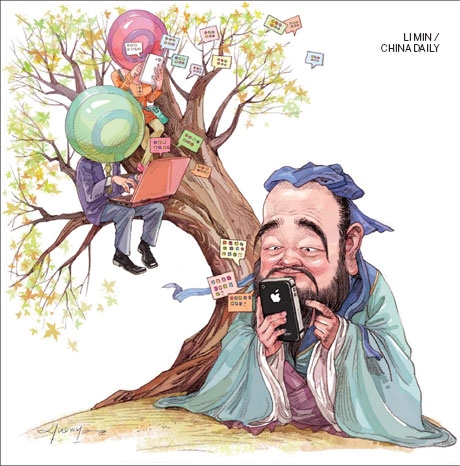Society
Micro blog leads revolution in China
By Zhang Jing, Yang Yang and Meng Jing (China Daily European Weekly)
Updated: 2011-04-22 09:50
 |
Large Medium Small |

Weibo may reshape Internet behavior in China over next few years
It is the new kid on the block and growing leaps and bounds. Soon it may tower like a goliath over other better known peers in the Web world as suitors from the government, public and corporate sector jostle for attention on its platform.
Weibo, or micro blog, the sending of brief text, audio or video to select groups, is making rapid strides in China and reshaping the way information flows with their multiple sources and diversified, authentic content. It is also becoming an attractive platform for companies to showcase their products and reach out to more consumers.
|
||||
A typical weibo starts with an "@" before the user's nickname, and like Twitter, has a word limit of 140 words. There is, however, one exception. Internet company Tom.com has set the weibo limit at 163 words to match with its parent company name 163.com. Unlike Twitter, a weibo can also be a picture, a voice message, a song and a video.
In February this year, Beijing rock singer He Yong posted a short message on his micro blog styled, "Weibo the Almighty, please save my child!" It was a request for help to cure his 30-month-old daughter as she refused to take any food or water for five days in a row. In the same month, the Ministry of Foreign Affairs saved over 900 stranded Chinese workers in Libya as they were able to locate them through their weibo messages for help.
The weibo power came to the fore in March, when irate netizens in Nanjing, Jiangsu province, led a campaign to stop the felling of the city's famed parasol trees for a subway construction. Netizens urged micro blog followers to hold protest meetings in front of a local library until the authorities agreed to their demands.
Nothing personifies the growing popularity of weibos than the example of a 12-year old boy in remote Fujian province who has a weibo account with all the four major providers - Sina, Tom, Tencent and Sohu.
Tencent, the world's third-largest Internet company by market capitalization, said in February this year that its number of registered weibo users has risen to nearly 100 million. Sina also claims that its numbers have swelled considerably and it has started making profits from the weibo services. That is indeed impressive, considering that the feat was achieved in less than two years, whereas it took Twitter nearly four years to build a network of 195 million users since inception in 2006.
Though Tencent and Sina are the biggest players among Chinese weibos, there is also a sea change when it comes to the customer profile on the two platforms. Tencent Weibo users are mostly teenagers who use the company's instant messaging service QQ, which has nearly 630 million active accounts. Users of the Sina services are in contrast aged between 30 and 40 and better educated.
With a big surge in user numbers expected by the end of this year, both the companies are leaving no stone unturned to boost market share. The Data Center of China Internet (DCCI) says that by the end of 2011, independent weibo users will reach 100 million and grow to 253 million by 2013. The weibo market is expected to take off from 2013, it says.
"Though the data differs from company to company, there is no doubt that micro blog is poised for explosive growth," says Liu Yan, director of Digital Influence with Ogilvy Public Relations Worldwide.
"Micro-blogging has a real-time news function," says Yang Guobin, author of The Power of the Internet in China: Citizen Activism Online and associate professor at the Barnard College of Columbia University in the United States.
"Its basic follower function gives a clearer structure to the increasing expansive and formless flow of information in cyberspace.
"By following another weibo user, I automatically receive his or her messages. Popular weibos can have large following. A person with a large following has enormous broadcasting power," says Yang.
By Jan 12 this year, the number of Tencent followers on Liu Xiang, China's 2004 Olympic 110-meter hurdle champion, crossed 10 million, well surpassing that of Lady Gaga on Twitter. Since then, Liu has become the most popular micro-blogger in the world.
Entrepreneur Lee Kai-fu, the former China head of Google, is another leading light in the weibo world and has more than 3 million followers. Lee admits that his entry into the weibo world was by chance. In June 2009, his friends told him that someone with the name of @kaifulee had been publishing news concerning Google and responding to fans' comments on Twitter. This made Lee aware of the power of Twitter.



